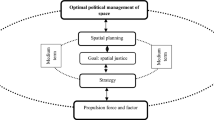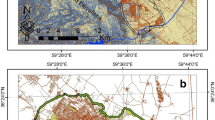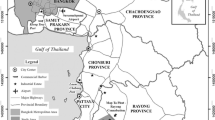Abstract
Spatial injustice is the main feature of Iran’s spatial organization. The consequences of injustice are the socio-economic and spatial inefficiencies that have led to the polar development of the Iran regions. The current research with the use descriptive-analytic method intends to perform scenario planning toward spatial justice in Iran regions. The key factors of the research were extracted from field studies. The non-probability sampling method was used to select the experts (30 N). MICMAC software was used for data analysis. The results showed that political and spatial power concentration, management and planning concentration, and top-down planning are the three most important influencing factors in spatial injustice in Iran. Scenario analysis indicates that in the most desirable scenario the optimal conditions (Regional balance and spatial justice) are superior to the current situations. In the second scenario important key factors are superior to the static condition. In the third scenario key factors are in intermediate conditions, but in the fourth scenario the unfavorable conditions prevail to the medium and desirable situations. Overall, it can be concluded that the current trend of spatial justice in Iran is based on third and fourth scenarios.
Access this chapter
Tax calculation will be finalised at checkout
Purchases are for personal use only
Similar content being viewed by others
References
Angel, S., & Blei, A. M. (2016). The spatial structure of American cities: The great majority of workplaces are no longer in CBDs, employment sub-centers, or live-work communities. Cities, 51, 21–35.
Christaller, W. (1966). Central places in southern Germany (Vol. 10). Prentice-Hall.
Coates, J. F. P., & Godet, M. (1994). From anticipation to action: A handbook of strategic prospective. Unesco publishing.
Dadashpoor, H., & Alidadi, M. (2017). Towards decentralization: Spatial changes of employment and population in Tehran metropolitan region Iran. Applied Geography, 85, 51–61.
Fearon, D. (2006). Alfred weber: Theory of the location of industries, 1909. Ŕ Center for Spatially Integrated Social Science.
Friedmann, J. (1967). A general theory of polarized development.
Ghaderi Hajat, M., & Hfeznia, M. R. (2020). Codification strategies for achieving spatial justice in Iran. Spatial Information Research, 28(3), 357–367.
Glenn, J. C., & Gordon, T. J. (Eds.). (2009). Futures research methodology-version 3-0. Editorial desconocida.
Godet, M. (2000). The art of scenarios and strategic planning: tools and pitfalls. Technological forecasting and social change, 65(1), 3–22.
Habermas, J. (1998). On the pragmatics of communication. MIT press.
Harvey, D. (2010). Social justice and the city (Vol. 1). University of Georgia Press.
Iran Program and Budget Organization. (2000). Document of the Third Economic, Social and Cultural Development Plan of the Islamic Republic of Iran.
Madani Kashani, Q., & Kabiri, M. (2008). Necessity of preparing and implementing regional development programs in the process of compiling national development plans. Proceedings of the First Conference for Compiling the Third Plan of the Country, 5(6), 1–1600.
Nordquist, M. (2013). Seeking spatial justice by Edward W Soja. Contemporary Political Theory, 12(1), e16–e18. https://doi.org/10.1057/cpt.2011.40
Philippopoulos-Mihalopoulos, A. (2014). The movement of spatial justice. Mondi Migranti.
Rawls, J. (2020). A theory of justice. Harvard University Press.
Soja, E. W. (2013). Seeking spatial justice (Vol. 16). U of Minnesota Press.
Taylor, P. J., Hoyler, M., & Verbruggen, R. (2010). External urban relational process: Introducing central flow theory to complement central place theory. Urban Studies, 47(13), 2803–2818.
Williams, J. (2018). Spatial justice as analytic framework.
Acknowledgements
The authors wish to thank Professor Albert Ziparo for his support and hospitality in the university of Florence, Italy.
Author information
Authors and Affiliations
Corresponding author
Editor information
Editors and Affiliations
Rights and permissions
Copyright information
© 2023 The Author(s), under exclusive license to Springer Nature Switzerland AG
About this paper
Cite this paper
Asadzadeh, H., Hatami, A. (2023). Future Study of Regional Spatial Structure in Iran (Horizon 2040). In: Alberti, F., Matamanda, A.R., He, BJ., Galderisi, A., Smol, M., Gallo, P. (eds) Urban and Transit Planning. Advances in Science, Technology & Innovation. Springer, Cham. https://doi.org/10.1007/978-3-031-20995-6_8
Download citation
DOI: https://doi.org/10.1007/978-3-031-20995-6_8
Published:
Publisher Name: Springer, Cham
Print ISBN: 978-3-031-20994-9
Online ISBN: 978-3-031-20995-6
eBook Packages: Earth and Environmental ScienceEarth and Environmental Science (R0)




